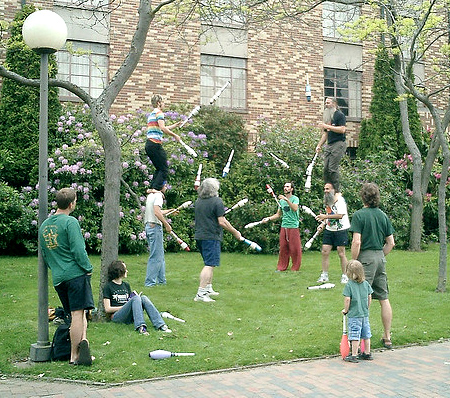
In a recent post (“How to Change the World: Simon Sinek on Leadership“), I talked about Simon Sinek’s TED talk, which boils down to “People don’t buy what you do; they buy why you do it.” By “buy,” Sinek also means “care,” “act,” “follow,” or “join in.” The principle fits sales, but it also fits social change, politics, the spread of ideas, and a lot else.
To have a “why” is to have a purpose, and I’ve begun to realize that having a purpose makes you nearly invincible. To explain that, let me tell you two stories. Let’s start with the failure.
The fall of the REALM
About 18 years ago I owned a small software development company outside Philadelphia, and I was hired to develop a software product to manage real estate and physical assets, like vehicles and storage tanks. The man behind the project at the client company was a friendly, energetic guy, and he quickly revealed that he was interested in doing more than just dealing with his own corporation’s needs: he had forged an agreement with the company such that they got free updates and enhancements and he would get rights to the software they paid to have developed. As I was the developer, he offered to split proceeds with me 50/50 if I would stay in the game and develop it further.
This was a golden opportunity. There was no software we could find that did what REALM (Real Estate, Assets, and Logistics Management) came to be able to do. REALM was easy to use, was inexpensive by corporate software standards, and was developed by an asset management specialist (him) and a skilled database and application developer (me). We made many enhancements and began to sell the software. We got a few clients, a few opportunities … and eventually fizzled. What should have been a business that could have made me financially secure for a long time, if not for life, turned out to be a time suck. Why? We had a good product. We had funding to develop it to a marketable state. We were both smart, friendly people. What happened?
I’ll tell you what happened: my heart wasn’t in it. When it came right down to it, I didn’t care about physical asset management, and even if I did, I didn’t care about the corporations that needed to do it. I was in the project for the money; that was basically it.
I don’t mean to suggest it was immoral or anything. After all, we need money to live in this society: without it, there would be a very real chance of starving or freezing to death on the street. Yet money has never really seemed that important to me in the grand scheme of things, and it was an utter failure for me as inspiration.
The rise of Codex
Now let’s shift gears and talk about something I’ve done that has been very successful: Codex. Codex is a free, online writers’ group designed originally for “neo-pro” fiction writers–that is, writers who are just beginning to prove themselves. (A number of its members have since become established pros, however.) The initial entrance requirements were either making a pro fiction sale or attending one of the major workshops where they choose participants from a writing sample. We later added alternative ways to qualify: getting a good agent or reaching a certain level of success with selfpub writing.
Codex was a ton of work. I had written a forum system in the past, and I used that for Codex instead of installing one of the common ones. Because I had done that, it wasn’t too hard to integrate a lot of features into the forum, like a critique exchange with tracked critique credit, contests with anonymous participation, a library of Codexians’ work, a blog tour system, and a lot more. The Codex forum as it now exists represents tens of thousands of dollars worth of custom programming, though I had never thought about it like that until just now.
Yet the technical work has been a minority of what I have done to keep the group running. I’ve participated in thousands of discussions, moderated, handled disputes, developed rules when they were needed, oriented new members, and otherwise run things that need running.
How has Codex worked out? Very, very well. We’ve barely made any effort to recruit members, but we get a steady stream of new applications. We’ve had over seven thousand discussions with well over 200,000 posts, over a thousand works critiqued, and dozens of contests over eight years. Our membership continues to grow bit by bit: last I checked, there were more than 230 active members. More and more members are selling novels and short stories and getting nominated for awards. On the current Nebula award ballot, every single person in the short story category is a member of Codex, though one of that group joined (without any solicitation from the group) after the nominations were announced.
Codex doesn’t net me any money–in fact, in the past it has cost me money, though this year a Codex member generously underwrote the cost of the entire year’s hosting as a celebration of his writing success. What’s more, these days I’m so busy with my own writing and related work, family, Taekwondo, and the daily demands of life that I can’t really even participate meaningfully in the discussions–I don’t have time. Yet Codex has provided meaningful friendships, my best professional opportunities in writing, huge amounts of insight, and a lot more. My first book sale (to a major publisher), my opportunity to do commentary for a Florida NPR affiliate, and my first professional speaking engagement all occurred because of Codex.
The thing is, I’ve never questioned my commitment to Codex because I have a purpose: to develop and be part of a community that helps its members improve their writing. If I hadn’t had that purpose, I would have given up on it a long time ago. My purpose protected Codex from getting derailed by problems like arguments among members (rare, but damaging), unreliable Internet hosting providers (we’ve had to switch service providers five times!), the need for complicated yet unpaid programming work, and so on.
There is no such thing as competition when you have purpose
Having a real purpose eliminates competition: people who are doing the same thing you’re doing for the same reason are helping you, because a real purpose is about something bigger than ourselves. People who are doing the “same” thing you’re doing for different reasons, often shallow ones, really aren’t doing the same thing at all.
I’ve recently started doing professional speaking events, and at first I was a bit worried that there would be too much competition for me to thrive. Yet I quickly came to realize that my speaking was an outgrowth of the same thing that has made this blog successful, which is a profound desire to first learn, then share knowledge of how to become a more empowered, compassionate, and happy human being. I don’t know whether that sounds hokey or not, but I do know that people who hear me speak do and will see that I am there to try to make their lives profoundly better. Anyone who’s doing the exact same thing has my admiration. Anyone who isn’t is no competition at all.
Photo by Lisa Tiyamiyu










